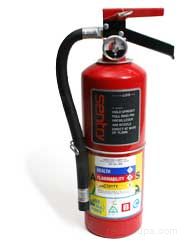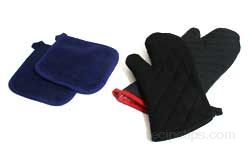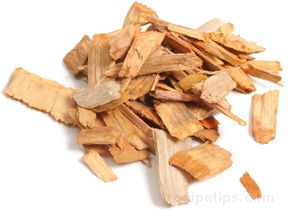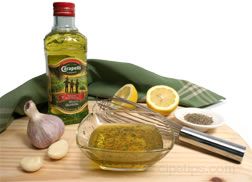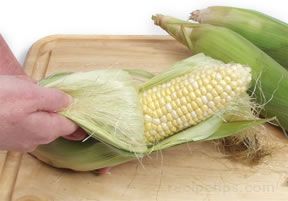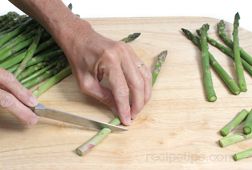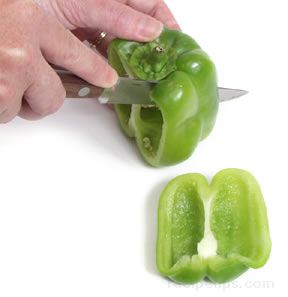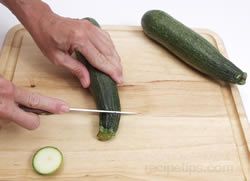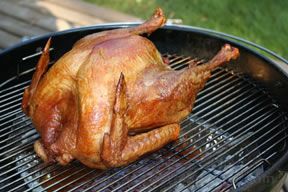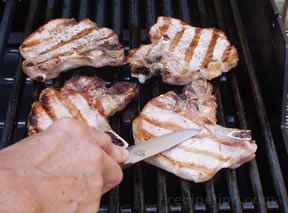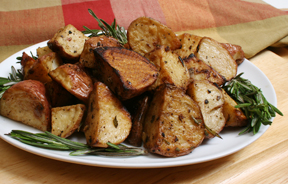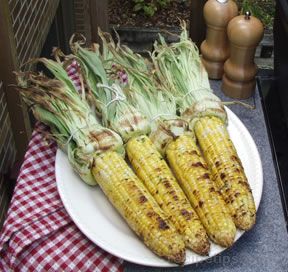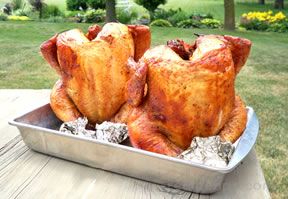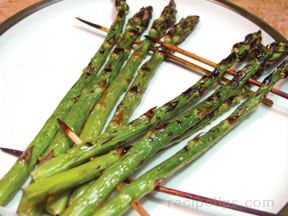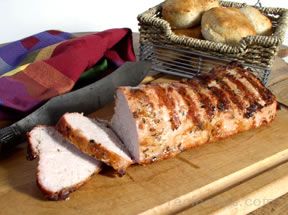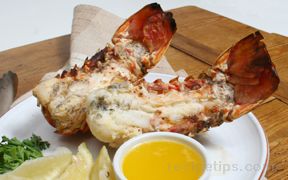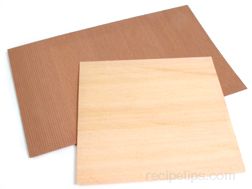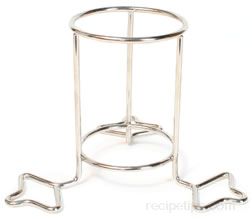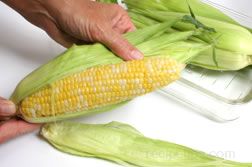|
Grilling with Direct Heat | Grilling with Indirect Heat
|
Cooking with direct heat and cooking with indirect heat are the methods most often used when grilling. It is important to understand the differences between the two methods to ensure success when grilling. Grilled food is most often cooked with one or the other of these cooking methods, but occasionally, both methods are used and are alternated to grill certain foods, which is often the case when grilling thick cuts of meat. The temperature required and the grilling method used, usually depends upon the type of food and the thickness of the food. |
Grilling with Direct Heat
| Grilling with direct heat is accomplished by placing food on the grilling grate in the area directly over the heat source. For outdoor grilling, the grate can be positioned over an open fire or wood burning grilling unit; a charcoal grill; or a gas grill. Direct heat grilling is the best method for foods such as hot dogs, brats, steaks, hamburgers, fish, and pork chops. |
| Grilling with Direct Heat Using a Charcoal Grill |

The best way to provide a consistently hot, even heat under the entire cooking surface of a charcoal grill is to spread the hot coals in an even layer on the bottom of the grill. This will ensure successful results for grilling foods with direct heat. |
|
 When direct heat is used for grilling on a charcoal grill, the cooking temperature typically reaches 450ºF to 650ºF. Foods that are thin, such as thin cuts of meat, are the best choices for grilling with direct heat because the food is grilled quickly and evenly when using such high temperatures. Thicker foods may burn on the exterior before the interior portions are fully cooked; therefore, direct heat grilling is not a good choice for such foods. When direct heat is used for grilling on a charcoal grill, the cooking temperature typically reaches 450ºF to 650ºF. Foods that are thin, such as thin cuts of meat, are the best choices for grilling with direct heat because the food is grilled quickly and evenly when using such high temperatures. Thicker foods may burn on the exterior before the interior portions are fully cooked; therefore, direct heat grilling is not a good choice for such foods.
When grilling thin foods over direct heat, the result is best when the food is turned only once to cook both sides. This is a technique that is similar to sautéing foods in a pan on a kitchen range. |
| Grilling with Direct Heat Using a Gas Grill |
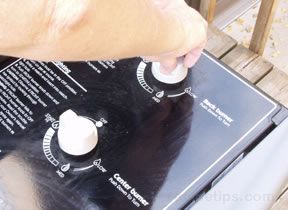
In order to provide a uniform temperature under the entire cooking surface when using a gas grill, all of the burners should be used. |
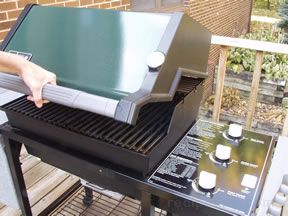
For direct heat grilling, the burners should be set no lower than medium heat after the grill is preheated. Thin foods, such as beefsteaks of ¾ inch thick or less, can be grilled over high heat for 2 to 3 minutes per side. Thin cuts of meat are best if turned only once during the grilling process. Cook the food with the hood down to ensure even doneness and check the food periodically to prevent overcooking. |

Use a tongs or a spatula to turn the food. A fork should not be used because it pierces the food allowing juices to escape. This is especially important when cooking meat. Hamburger patties should be turned with a spatula. |
Grilling with Indirect Heat
| Foods grilled with indirect heat are cooked with a heat source that is not directly under the food. This allows thick food items to be cooked slowly, which is necessary to ensure that the food does not burn on the exterior surface before the interior portion reaches the proper doneness. Foods such as beef roasts, pork roasts, whole turkeys, and whole chickens are good choices for grilling with indirect heat.
Indirect heat grilling is often used in conjunction with direct heat grilling. Large meat cuts, for example, may be seared directly over high heat, which helps to seal in the juices, thereby maintaining tenderness. The meat is then placed in an area of the grilling grate that is away from the heat source in order for the indirect heat to cook the meat slowly until it has reached the proper doneness.
After completing the preliminary procedures of readying the grill and preparing the food for cooking, several easy steps, as described in the following, will provide success in grilling with indirect heat. |
| Grilling with Indirect Heat Using a Charcoal Grill |

When using a charcoal grill, push the hot coals (with long handled metal tongs or fireplace implement) to one side of the grill. Place a pan on the opposite side of the grill next to the charcoal. The purpose of the pan is to catch drippings from the food, which could otherwise cause flare-ups if allowed to drip on the grill unit. A disposable aluminum pan is a good choice for this purpose. |
 If grilling a thick cut of meat, it is beneficial to sear all sides of the meat over direct heat. The meat is placed directly over the area above the hot charcoal and is turned with a tongs. Utensils that pierce the meat, such as a large fork, should not be used because piercing the meat will allow juices to escape, toughening the meat. Searing the meat for three or four minutes is often adequate for producing a flavorful crust and contributing to a tender, juicy result when the grilling is complete. If grilling a thick cut of meat, it is beneficial to sear all sides of the meat over direct heat. The meat is placed directly over the area above the hot charcoal and is turned with a tongs. Utensils that pierce the meat, such as a large fork, should not be used because piercing the meat will allow juices to escape, toughening the meat. Searing the meat for three or four minutes is often adequate for producing a flavorful crust and contributing to a tender, juicy result when the grilling is complete. |

When the meat is adequately seared, place it on the opposite side of the grill over the drip pan, away from the hot coals. It is important to close the lid on the grill during the grilling process to maintain an even temperature and ensure proper doneness of the food. The meat can be checked periodically to ensure that it does not become overcooked. |
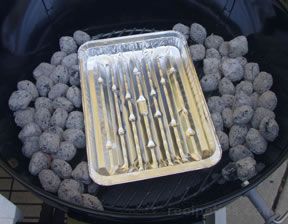
A second method for arranging the charcoal for indirect heat grilling is to divide the coals in half; placing one half of the coals on one side and the other half on the opposite side. Leave an open area in the middle of the grill in which to place the drip pan. Close the lid of the grill during the grilling process to ensure even cooking of the food. There are several manufacturers of charcoal grills that equip their grills with side baskets that can be used for this configuration. |
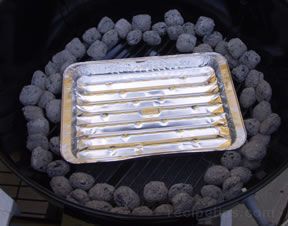
A third configuration for arranging the charcoal is to create a ring of coals around the edge of the grill. As with the other two charcoal arrangements, a drip pan should be used under the area where the food will be cooked and the grill should be covered during the grilling process. |
| Grilling with Direct Heat Using a Gas Grill |
 When grilling a thick cut of meat on a gas grill, it is beneficial to sear all sides of the meat over direct heat, similar to what was described in grilling with indirect heat using a charcoal grill. The meat is placed directly over the area above the burner and is turned with a tongs as it is seared. Utensils that pierce the meat, such as a large fork, should not be used because piercing the meat will allow juices to escape, toughening the meat. Three or four minutes should be adequate to properly sear the meat. When grilling a thick cut of meat on a gas grill, it is beneficial to sear all sides of the meat over direct heat, similar to what was described in grilling with indirect heat using a charcoal grill. The meat is placed directly over the area above the burner and is turned with a tongs as it is seared. Utensils that pierce the meat, such as a large fork, should not be used because piercing the meat will allow juices to escape, toughening the meat. Three or four minutes should be adequate to properly sear the meat. |
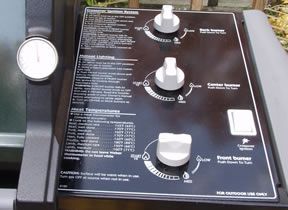
After performing the necessary steps for preheating the gas grill, turn off all but one of the burners. On the three burner grill shown, the center and rear burners were switched off and the front burner was left on its highest temperature setting. |

Place a drip pan under the location where the meat will be cooked, away from the direct heat of the front gas burner. |
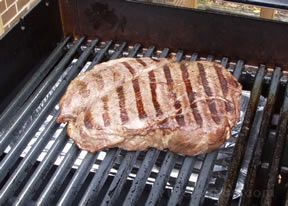
Position the seared meat on the area of the grilling grate over the drip pan, away from the direct heat of the front burner. |

It is important to close the hood of the grill to hold in the heat. One burner is sufficient to produce enough heat for proper indirect heat grilling if the hood is closed. |

Large cuts of meat benefit from grilling with indirect heat because the meat remains tender and juicy and the risk of overcooking the meat is reduced. | |






 When direct heat is used for grilling on a charcoal grill, the cooking temperature typically reaches 450ºF to 650ºF. Foods that are thin, such as thin cuts of meat, are the best choices for grilling with direct heat because the food is grilled quickly and evenly when using such high temperatures. Thicker foods may burn on the exterior before the interior portions are fully cooked; therefore, direct heat grilling is not a good choice for such foods.
When direct heat is used for grilling on a charcoal grill, the cooking temperature typically reaches 450ºF to 650ºF. Foods that are thin, such as thin cuts of meat, are the best choices for grilling with direct heat because the food is grilled quickly and evenly when using such high temperatures. Thicker foods may burn on the exterior before the interior portions are fully cooked; therefore, direct heat grilling is not a good choice for such foods.



 If grilling a thick cut of meat, it is beneficial to sear all sides of the meat over direct heat. The meat is placed directly over the area above the hot charcoal and is turned with a tongs. Utensils that pierce the meat, such as a large fork, should not be used because piercing the meat will allow juices to escape, toughening the meat. Searing the meat for three or four minutes is often adequate for producing a flavorful crust and contributing to a tender, juicy result when the grilling is complete.
If grilling a thick cut of meat, it is beneficial to sear all sides of the meat over direct heat. The meat is placed directly over the area above the hot charcoal and is turned with a tongs. Utensils that pierce the meat, such as a large fork, should not be used because piercing the meat will allow juices to escape, toughening the meat. Searing the meat for three or four minutes is often adequate for producing a flavorful crust and contributing to a tender, juicy result when the grilling is complete.


 When grilling a thick cut of meat on a gas grill, it is beneficial to sear all sides of the meat over direct heat, similar to what was described in grilling with indirect heat using a charcoal grill. The meat is placed directly over the area above the burner and is turned with a tongs as it is seared. Utensils that pierce the meat, such as a large fork, should not be used because piercing the meat will allow juices to escape, toughening the meat. Three or four minutes should be adequate to properly sear the meat.
When grilling a thick cut of meat on a gas grill, it is beneficial to sear all sides of the meat over direct heat, similar to what was described in grilling with indirect heat using a charcoal grill. The meat is placed directly over the area above the burner and is turned with a tongs as it is seared. Utensils that pierce the meat, such as a large fork, should not be used because piercing the meat will allow juices to escape, toughening the meat. Three or four minutes should be adequate to properly sear the meat.






